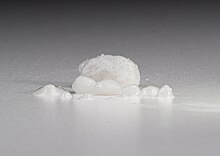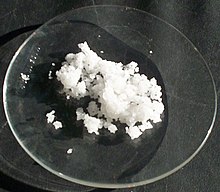
Back كلوريد الزنك Arabic کولورید چینکو AZB Цинков хлорид Bulgarian Clorur de zinc Catalan Chlorid zinečnatý Czech Zinkklorid Danish Zinkchlorid German Χλωριούχος ψευδάργυρος Greek Zinka klorido Esperanto Cloruro de zinc Spanish
 Anhydrous
| |
 Monohydrate
| |

| |
| Names | |
|---|---|
| IUPAC name
Zinc chloride
| |
Other names
| |
| Identifiers | |
| |
3D model (JSmol)
|
|
| ChEBI | |
| ChEMBL | |
| ChemSpider | |
| DrugBank | |
| ECHA InfoCard | 100.028.720 |
| EC Number |
|
PubChem CID
|
|
| RTECS number |
|
| UNII | |
| UN number | 2331 |
CompTox Dashboard (EPA)
|
|
| |
| |
| Properties | |
| ZnCl2 | |
| Molar mass | 136.315 g/mol |
| Appearance | White hygroscopic and very deliquescent crystalline solid |
| Odor | odorless |
| Density | 2.907 g/cm3 |
| Melting point | 290 °C (554 °F; 563 K)[1] |
| Boiling point | 732 °C (1,350 °F; 1,005 K)[1] |
| 432.0 g/100 g (25 °C) 615 g/100 g (100 °C) | |
| Solubility | soluble in ethanol, glycerol and acetone |
| Solubility in ethanol | 430.0 g/100 ml |
| −65.0·10−6 cm3/mol | |
| Structure | |
| Tetrahedral, linear in the gas phase | |
| Pharmacology | |
| B05XA12 (WHO) | |
| Hazards | |
| Occupational safety and health (OHS/OSH): | |
Main hazards
|
Oral toxicity, irritant[2] |
| GHS labelling: | |
  
| |
| Danger | |
| H302, H314, H410 | |
| P273, P280, P301+P330+P331, P305+P351+P338, P308+P310 | |
| NFPA 704 (fire diamond) | |
| Lethal dose or concentration (LD, LC): | |
LD50 (median dose)
|
|
LC50 (median concentration)
|
1260 mg/m3 (rat, 30 min) 1180 mg-min/m3[4] |
| NIOSH (US health exposure limits): | |
PEL (Permissible)
|
TWA 1 mg/m3 (fume)[3] |
REL (Recommended)
|
TWA 1 mg/m3 ST 2 mg/m3 (fume)[3] |
IDLH (Immediate danger)
|
50 mg/m3 (fume)[3] |
| Safety data sheet (SDS) | External SDS |
| Related compounds | |
Other anions
|
|
Other cations
|
|
Except where otherwise noted, data are given for materials in their standard state (at 25 °C [77 °F], 100 kPa).
| |
Zinc chloride is an inorganic chemical compound with the formula ZnCl2·nH2O, with n ranging from 0 to 4.5, forming hydrates. Zinc chloride, anhydrous and its hydrates, are colorless or white crystalline solids, and are highly soluble in water. Five hydrates of zinc chloride are known, as well as four forms of anhydrous zinc chloride.[5]
All forms of zinc chloride are deliquescent and are produced by the reaction of zinc or its compounds with some form of hydrogen chloride. This compound is a Lewis acid, readily forming complexes. Zinc chloride finds wide application in textile processing, metallurgical fluxes, chemical synthesis of organic compounds, such as benzaldehyde, and processes to produce other compounds of zinc.[5]
- ^ a b O'Neil, M. J.; et al. (2001). The Merck index : an encyclopedia of chemicals, drugs, and biologicals. N. J.: Whitehouse Station. ISBN 978-0-911910-13-1.
- ^ "Zinc chloride safety data sheet". Sigma-Aldrich. March 2, 2024. Retrieved May 21, 2024.
- ^ a b c NIOSH Pocket Guide to Chemical Hazards. "#0674". National Institute for Occupational Safety and Health (NIOSH).
- ^ a b "Zinc chloride fume". Immediately Dangerous to Life or Health Concentrations (IDLH). National Institute for Occupational Safety and Health (NIOSH).
- ^ a b Cite error: The named reference
awas invoked but never defined (see the help page).
